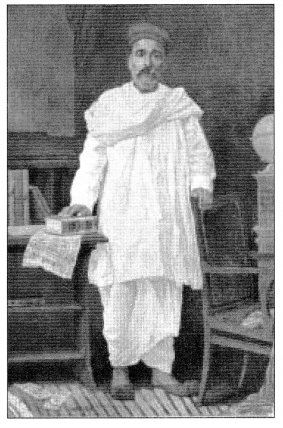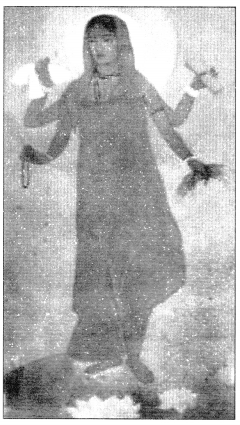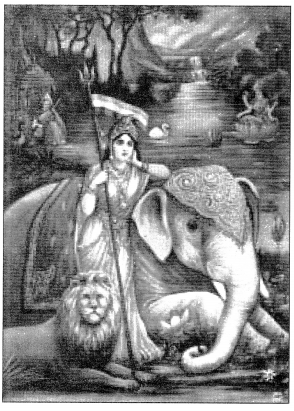Check the below NCERT MCQ Questions for Class 10 History Chapter 3 Nationalism in India with Answers Pdf free download. MCQ Questions for Class 10 Social Science with Answers were prepared based on the latest exam pattern. We have Provided Nationalism in India Class 10 History MCQs Questions with Answers to help students understand the concept very well. https://mcqquestions.guru/mcq-questions-for-class-10-history-chapter-3/
Nationalism in India Class 10 MCQs Questions with Answers
Choose the correct option:
Nationalism In India Class 10 MCQ Question 1.
The Non-cooperation Movement began on which one of the following dates?
(a) January 1921
(b) November 1921
(c) December 1921
(d) May 1921
Answer
Answer: (a) January 1921
Nationalism In India MCQ Question 2.
In which of the following places Mahatma Gandhi organised satyagraha for the first time in India?
(a) Dandi
(b) Ahmedabad
(c) Kheda
(d) Champaran
Answer
Answer: (d) Champaran
MCQ On Nationalism In India Class 10 Question 3.
Who among the following was associated with the formation of Swaraj Party within the Congress?
(a) Subhas Chandra Bose
(b) Motilal Nehru
(c) Jawaharlal Nehru
(d) Dadabhai Naoroji
Answer
Answer: (b) Motilal Nehru
MCQ Questions For Class 10 Icse History Chapter 3 Question 4.
In which of the following Indian National Congress sessions was the demand of‘Purna Swaraj’ formalised in December 1929?
(a) Madras Session
(b) Lahore Session
(c) Calcutta Session
(d) Nagpur Session
Answer
Answer: (b) Lahore Session
MCQ Questions For Class 10 Icse History Question 5.
Who organised the dalits into the Depressed classes Association?
(a) Dr. B.R. Ambedkar
(b) Jawaharlal Nehru
(c) Mahatma Gandhi
(d) Motilal Nehru
Answer
Answer: (a) Dr. B.R. Ambedkar
Class 10 History Chapter 3 MCQ With Answers Question 6.
Why had the Congress ignored the dalits for long?
(a) Due to their liberal outlook
(b) Due to fear from the Britishers
(c) For fear of offending the sanatanis
(d) For fear of Dr B.R. Ambedkar
Answer
Answer: (c) For fear of offending the sanatanis
MCQ Questions For Class 10 Icse History Pdf Question 7.
Who created the first image of Bharat Mata?
(a) Bankim Chandra Chattopadhyay
(b) Subhash Chandra Bose
(c) Rabindranath Tagore
(d) Abanindranath Tagore
Answer
Answer: (a) Bankim Chandra Chattopadhyay
Class 10 Nationalism In India MCQ Question 8.
Which of the following combination of colours was there in the ‘Swaraj flag’ designed by Gandhiji in 1921?
(a) red, green and white
(b) red, green and yellow
(c) orange, white and green
(d) yellow, white and green
Answer
Answer: (a) red, green and white
MCQ Of Nationalism In India Class 10 Question 9.
Who announced a vague offer of‘Dominion Status’ for India in 1929?
(a) Lord Curzon
(b) Viceroy Irwin
(c) Lord William Bentick
(d) Lord Mountbalten
Answer
Answer: (b) Viceroy Irwin
Nationalism In India Class 10 MCQ Pdf Question 10.
Which of the following agreements gave reserved seats to the ‘Depressed classes’ in provincial and central legislative councils?
(a) Lucknow Pact
(b) Gandhi Irwin Pack
(c) Poona Pact
(d) None of these
Answer
Answer: (c) Poona Pact
MCQ Of Nationalism In India Question 11.
In which year the Second Round Table Conference was held?
(a) 1931
(b) 1935
(c) 1938
(d) 1945
Answer
Answer: (a) 1931
Explanation:
In December 1931, Gandhiji attended the second round table conference by demanding separate electorates for dalit.
Nationalism In India Class 10 MCQs Question 12.
What was the demand of 1929 sessions of the Congress at Lahore ?
(a) Poorna Swaraj
(b) Right to speech
(c) Half authority
(d) None of these
Answer
Answer: (a) Poorna Swaraj
Nationalism In India MCQ Class 10 Question 13.
Who started the Swaraj Party?
(a) Jawaharlal Nehru
(b) Mahatma Gandhi
(c) C.R.Das
(d) C.R. Das and Motilal Nehru.
Answer
Answer: (d) C.R. Das and Motilal Nehru.
Explanation:
C. R. Das and Motilal Nehru formed the Swaraj Party because they wanted to enter the Provincial Councils and oppose British policies.
Nationalism In India MCQs Question 14.
Why was the slogans demanding “Swatantra Bharat” important?
(a) It showed the greatness of Mahatma Gandhi
(b) They were going beyond their own locality and emotionally identifying with an all-India movement
(c) They were a unifying force of the Non-Cooperation Movement
(d) The various ways in which ‘Swaraj’ was interpreted by different people
Answer
Answer: (b) They were going beyond their own locality and emotionally identifying with an all-India movement
Explanation:
When the tribals chanted Gandhiji’s name and raised slogans demanding ‘Swatantra Bharat’, they were also emotionally relating to an all-India agitation. They were going beyond their own locality and emotionally identifying with an all-India movement.
Nationalism In India Class 10 MCQ With Answers Question 15.
When did the Jallianwalla Bagh incident take place?
(a) On 13 April
(b) On 15 August
(c) On 27 October
(d) On 10 March
Answer
Answer: (a) On 13 April
Explanation:
On 13 April the Jallianwalla Bagh incident took place. On that day a large crowd gathered in the enclosed ground of Jallianwalla Bagh, unaware of the martial law that had been imposed. Dyer entered the area, blocked the exit points, and opened fire on the crowd, killing hundreds.
Question 16.
What were boycotted during Non-cooperation movement?
(a) Foreign goods
(b) Food
(c) Water
(d) None of these
Answer
Answer: (a) Foreign goods
Explanation:
At the time of Non-cooperation movement foreign goods were boycotted as the symbol of foreign trade and it begins with the surrender of titles that the government awarded, and a boycott of civil services, army, police, courts and legislative councils and schools.
Question 17.
Who published ‘The Folklore of Southern India’?
(a) Natesa Sastri
(b) Dr.Ambedkar
(c) Mahatma Gandhi
(d) None of these
Answer
Answer: (a) Natesa Sastri
Explanation:
In Madras, Natesa Sastri published a massive four-volume collection of Tamil folk tales, The Folklore of Southern India.
Question 18.
What was the reason for Mahatma Gandhiji’s fast unto death in 1932?
(a) The clash with Dr. Ambedkar
(b) The Clash with Bose
(c) The clash with Nehru
(d) None of these
Answer
Answer: (a) The clash with Dr. Ambedkar
Explanation:
The clash with Dr Ambedkar over his demand for a separate electorate for Dalits which he thought would halt their integration into society, led mahatma Gandhi to do fast unto death in 1932.
Question 19.
Who was the two great writers of Bengal and Madras, who contributed to nationalism in the late nineteenth century?
(a) Rabindranath Tagore and Natesa Sastri
(b) Jamini Roy and Ravi Verma
(c) Rabindranath Tagore and Ravi Verma
(d) None of these
Answer
Answer: (a) Rabindranath Tagore and Natesa Sastri
Explanation:
The two great writers of Bengal and Madras, who contributed to nationalism in the late nineteenth century through folklore, were Rabindra Nath tagore and Natesa Sastri
Question 20.
Who was the President of the Muslim League in 1930?
(a) Mr. M.A. Jinnah
(b) Maulana Azad
(c) Abdul Ghaffar Khan
(d) Sir Muhammad Iqbal
Answer
Answer: (d) Sir Muhammad Iqbal
Explanation:
In 1930, Sir Muhammad Iqbal, as president of the Muslim League, reiterated the importance of separate electorates for the Muslims as an important safeguard for their minority political interests.
Question 21.
The Non-Cooperation Movement was started by Mahatma Gandhi in support of which movement?
(a) Khilafat
(b) Swaraj
(c) Khilafat and Swaraj
(d) none of these
Answer
Answer: (c) Khilafat and Swaraj
Explanation:
At the Calcutta session of the Congress in September 1920, he convinced other leaders of the need to start a non-cooperation movement in support of Khilafat as well as for Swaraj.
Question 22.
Who was the author of the famous novel ‘Anandamath’?
(a) Bankim Chandra Chattopadhyay
(b) Abanindranath Tagore
(c) Natesa Sastri
(d) Rabindranath Tagore
Answer
Answer: (a) Bankim Chandra Chattopadhyay
Explanation:
Bankim Chandra Chattopadhyay was the author of the famous novel ‘Anandamath’. In the 1870s he wrote ‘Vande Mataram’ as a hymn to the motherland. His novel Anandamath and widely sung during the Swadeshi movement in Bengal.
Question 23.
What was the reason behind clash between Gandhi Ji and Dr Ambedkar?
(a) Separate electorates would create division in the society.
(b) Separate electorates would slow down the progress of integration into society.
(c) With separate electorates, Dalit’s would gain respect in society.
(d) The condition of Dalit’s would become better.
Answer
Answer: (a) Separate electorates would create division in the society.
Explanation:
Gandhiji began fast unto death when Dr. B.R. Ambedkar demanded separate electorate for dalits because Separate electorates would create division in the society.
Question 24.
When did Gandhiji travelled to Champaran in Bihar?
(a) 1916
(b) 1920
(c) 1925
(d)1918
Answer
Answer: (a) 1916
Explanation:
In 1916 he travelled to Champaran in Bihar to inspire the peasants to struggle against the oppressive plantation system.
Question 25.
Which one of the following leaders headed Oudh Kisan Sabha?
(a) Jawahar Lal Nehru
(b) Mahatma Gandhi
(c) Subhash Chandra Bose
(d) Motilal Nehru
Answer
Answer: (a) Jawahar Lal Nehru
Explanation:
By October, the Oudh Kisan Sabha was set up headed by Jawaharlal Nehru, Baba Ramchandra and a few others. Within a month, over 300 branches had been set up in the villages around the region.
Picture-based Questions:
Question 1.
Identify the following personality (NCERT TB page 70) and write a short paragraph on him highlighting his contribution to the Indian national movement.

Answer
Answer:
This is the portrait of Bal Gangadhar Tilak, a great leader of Indian national movement. He played a very significant role in national movement. Indian National Congress was divided into two wings- Moderate and Extremist. He was the first extremist leader who declared “Swaraj is my birth right and I must have it”. He organised the nationalist movement in Maharashtra and brought it in conflict with the British government.
He united the moderates and extremists of Congress Party. He appealed Indian people to boycott British goods, British courts, schools and colleges. He was sent to jail numerous times by the Britishers. He infused the spirit of self sacrifice among the Indian masses. Movement. Thus his contribution paved a new path to the Indian national movement.
Question 2.
Look at the picture taken from NCERT Textbook Page 71 and answer the questions that follow.

(i) What is this image of?
(ii) Who painted this image and when?
(iii) How does the painter portray Bharat Mata?
Answer
Answer:
(i) This is the image of Bharat Mata.
(ii) Abanindranath Tagore painted this image in 1905.
(iii) The painter portrays Bharat Mata as an ascetic figure. She is calm, composed, divine and spiritual.
Question 3.
Look at the picture taken from NCERT Textbook Page 72 and answer the questions that follow.

(i) What is depicted in the above picture?
(ii) What was its significance during the freedom struggle?
Answer
Answer:
(i) In this picture, Bharat Mata is shown with a trishul standing beside a lion and an elephant. These are the symbols of power and authority.
(ii) The image of Bharat Mata was an icon to create nationalist feeling in Indians during the freedom struggle. It shows that Indians should fight against the Britishers vehemently.
How do you think to help the depressed classes in India? Express your opinion.
Answer
Answer:
The depressed classes should be helped in India by the government NGOs and the society. At first, they must be given moral support so that they may come into the mainstream of the society. They must be provided educational facilities. This way they may come into the public and private sectors and their representation may be felt in the society. In politics they must be given proper representation.
We hope the given NCERT MCQ Questions for Class 10 History Chapter 3 Nationalism in India with Answers Pdf free download will help you. If you have any queries regarding Nationalism in India CBSE Class 10 History MCQs Multiple Choice Questions with Answers, drop a comment below and we will get back to you soon.